In the immediate aftermath of World War II, multiple experimental Japanese tanks disappeared with little trace. Due to the widespread stories (perhaps overblown in this regard) of the Japanese armed forces disposing of secret weapons prior to American occupation, it is generally assumed that such was their fate.
Still, there are a few cases of experimental Japanese vehicles being explicitly scrapped by American forces, either due to misidentification or disinterest. Most famous is the following scene, which depicts the imminent destruction of four tanks: two are clearly the Type 97 Medium Tank (Chi-Ha), while the closest tank, facing almost perpendicular to the point of view, was widely considered to be the only photograph of the experimental medium tank “Chi-Ho”. The rightmost tank is also unidentified, and there is no commonly accepted explanation for its identity.
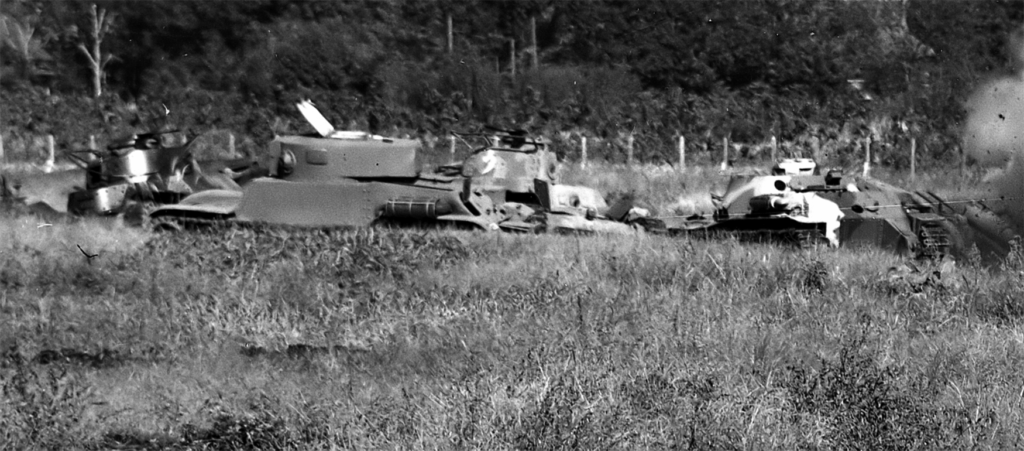
The footage of this scene, along with several other distinct locations, appears in this reel archived by the Sherman Grinberg Library, a copy of which is distributed by Getty Images.
While the archive holder claims that the film was compiled on November 15th, 1945, and takes place in the Ōmori district of Tōkyō, this is inaccurate. The footage is actually a compilation of several distinct scenes in the general area west of Tōkyō – none of which are Ōmori.
Recently, I came across a part of the original footage that was used to make the compilation film linked above. Below I have embedded the part which shows the destruction of tanks. The film is digitized by the NARA, and available here.
This reel shows various activities of the Americal Division during the occupation of Japan. As it turns out, all of the scenes in the compilation film mentioned previously were carried out by the Americal Division as well. By analyzing unit records, aerial photography, and the scenery visible in each segment, I have been able to locate the position where each scrapping incident occurred.
But first, is the mystery tank in the final scene actually a “Chi-Ho” as it is commonly stated?
Our mystery tank is by and large considered to be the experimental medium tank “Chi-Ho”. This is a natural conclusion, as the tank appears to have a Chi-Ho turret – characterized by the offset MG ball mount next to the mantlet, cylindrical turret shape with a rear overhang, and double turret hatches with no cupola. While the turret identification appears to be sound, the details of the hull are where it gets uncertain.

The Chi-Ho was a prototype-only medium tank that was trialed as the successor to the Chi-Ha, at a time when the Chi-Ha was still technically regarded as experimental. While the Chi-Ha would ultimately be the last Japanese medium tank to see combat, its appraisal from the beginning was not uniformly positive, and the Chi-Ho is generally regarded as a revival of the push for a lighter vehicle.
The character of the Chi-Ho is essentially a marginally lighter medium tank than the Chi-Ha, with a 47mm tank gun emphasizing anti-tank fighting capabilities, as well as a coaxial or offset MG mount in the turret. According to Shikenshi (四研史), four prototypes of the Chi-Ho were manufactured – two by TAI (Tōkyō Automobile Industries) and MHI (Mitsubishi Heavy Industries) in August 1940, and two by the Sagami Army Arsenal and Kokura Army Arsenal in March 1941.
However, to date, there only seems to be compelling evidence for the existence of the TAI and MHI Chi-Ho prototypes. Furthermore, it was a rather rare affair for the Arsenals themselves to handle the design and construction of a tank independently. Typically, the Arsenals supervised the construction of tanks at civilian companies.
Basic sketches of the appearance of the TAI and MHI Chi-Ho prototypes exist in the document「チホ車試作完成報告」(Chi-Ho Prototype Completion Report) that was finalized by MHI in July 1941. Parts of this document have been published in the 20th edition of the magazine J-Tank. The lack of reference to the Sagami or Kokura Chi-Ho in this report seems to put their existence in doubt.

Source: Mainichi Photobank

Source: Mainichi Photobank
The physical appearance of the TAI and MHI Chi-Ho prototypes can be verified in a few photos that were only recognized in the last few years. Until then, the “mystery tank” photo was regarded as the only photo of the “Chi-Ho”.
There appears to be no known reference to the existence of a “Sagami Chi-Ho”. There are limited references to a “10 ton tank” being developed by the Kokura Arsenal, which was delivered to the Technical HQ in March 1941, which is the same month the TAI and MHI Chi-Ho are thought to have been delivered to the Technical HQ.
In my opinion, with the available amount of evidence, it is likely the case that the Sagami and Kokura Arsenals merely collaborated with or supervised the civilian companies TAI and MHI in developing two Chi-Ho prototypes, and did not actually produce unique prototypes themselves. The Kokura Arsenal was already participating in the development of the Ke-Ni prototypes with the TAI at this time, so I think it is likely the case that the “Kokura Chi-Ho” was the TAI Chi-Ho, and the “Sagami Chi-Ho” was the MHI Chi-Ho.
This leaves us with a problem. If the Sagami Arsenal never built a unique Chi-Ho, and the known TAI/MHI prototypes do not match the “mystery tank” in the footage, we are left with a ghost tank. We need a vehicle that fits the timeline, the location, and the physical characteristics of this wreck.
I would propose that there is a considerable chance that this vehicle is the experimental light tank Ke-Ho, the last Japanese light tank, which was reportedly prototyped in 1945. I want to emphasize that this is only a theory.
The commonly accepted appearance of the Ke-Ho is shown below, which was drawn by Akira Takeuchi in 日本の戦車 (Japanese Tanks). However, this form of the Ke-Ho, which basically appears to be an enlargement of the previous Ke-Ni with externalized suspension elements and a 47mm turret, is based largely on information in the US postwar document “ORD TIR 21”.
In “ORD TIR 21” it is explicitly noted that the Americans were unable to obtain drawings or detailed design data of the Ke-Ho, as it had all been burned by the development company, Hino Heavy Industries. Therefore, the information was obtained by recollection and cross-checked with officials from the Shiken.
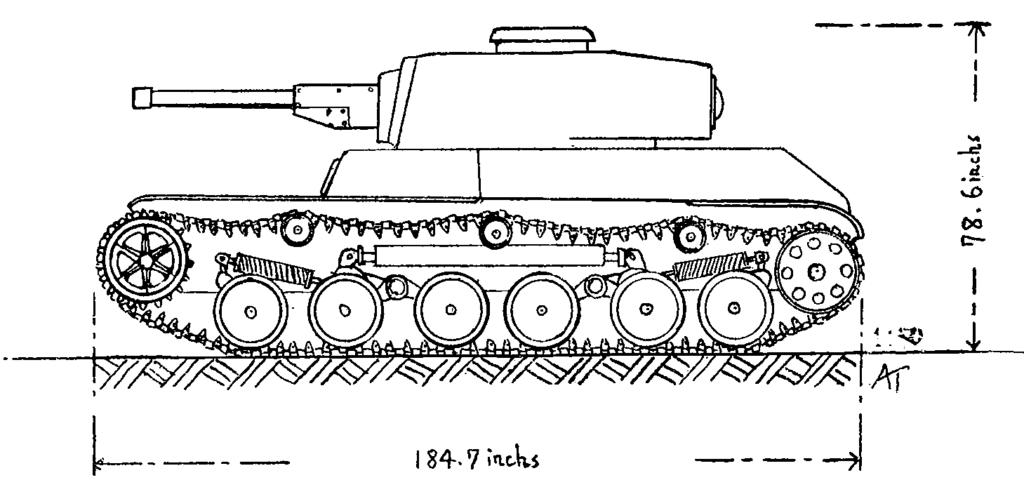
What is interesting about this situation is that the US information on the Ke-Ho does not agree with information later published by the Hino Motors company in the book「日野自動車技術史」(Technical History of Hino Motors). In fact, what appears in the latter is much more detailed, and is more in line with Takeuchi’s drawing of the vehicle seen in the scrapping footage after the war, that is, what he thought to be the “Chi-Ho”.

Notably, the specifications of the Ke-Ho given by Hino Motors state that it had five roadwheels per side, not six. However, it is unclear if Takeuchi actually had insight into the suspension of the vehicle as he drew it here, or whether he merely estimated its appearance.
Still, there are further reasons that I believe support this vehicle being the Ke-Ho:
- The mystery vehicle only has a single exhaust pipe (unusually on the left side), which indicates that it likely had an inline engine typical of light tanks.
- While there was a proposal to produce prototypes of the Chi-Ho with an inline A6120VD engine (that of the Ha-Gō), the A6120VD is a left -> right airflow engine both in terms of the cooling air and intake/exhaust.
- On the other hand, if the Hino DB52 engine is installed in this vehicle, as according to the specifications of the Ke-Ho, it is natural that the exhaust pipe will be on the left side.
For context, the Ha-Gō had its inline A6120VD engine arranged longitudinally in the conventional manner, where the drive shaft passes centrally though the vehicle, reaching the transmission between the driver and bow gunner. As mentioned, the airflow of this engine was left → right.
Japanese light tanks from the Ke-Ni onward adopted an unconventional transverse arrangement. In this layout, the driveshaft emerged from the side of the engine asymmetrically, running along the left side of the hull to the transmission. This was a measure to reduce the vehicle’s length, but it necessitates that the driver’s position is centralized in the front of the hull. The bow gunner was eliminated, as the Ke-Ni was the first Japanese light tank with a coaxial machine gun.

It is expected that this trend was ultimately reversed with the Ke-Ho, due to the fact that the Ke-Ho, perhaps as a result of its lack of a coaxial machine gun, reverted to the conventional crew layout with a driver and bow gunner in the front of the hull.
The Ke-Ni used the Standardized Type 100 diesel engine (in the 6-cylinder inline format). The Ke-Ho was also slated to use a supercharged version of this same powerplant. However, there were multiple subformats of this engine, and the distinction is critical:
- MHI Variant (Model AB): Produced for the Ke-Ni and Ke-To with a transverse arrangement.
- HHI Variant (Model DB52): Produced for the APC Ho-Ki and Ho-Ha with a longitudinal arrangement.
*Technically speaking, AB and DB52 are merely each company’s designation for the same basic engine, but it appears that they mass produced them with distinctions as above.

Crucially, the DB52 engine had a left → right airflow in its typical APC installation (mounted at the front, driveshaft running rearward). When installed in the Ke-Ho, the engine would be mounted in the rear, and effectively rotated 180 degrees relative to the APC layout. Consequently, the airflow reverses relative to the hull, resulting in a right → left airflow without requiring a new, specialized variant. This could explain the mystery vehicle’s unique exhaust.
Finally, there is one last major reason that I suspect this mystery tank is the Ke-Ho. To the right of it is another mystery vehicle, as previously mentioned. This one is truly unknown, and there are few who even attempt to identify it. It is a very low profile vehicle, with an unusual style of cupola on the right side of the crew compartment. The vehicle appears to have been constructed with a lengthened ground contact area, as the rear idlers are positioned on extrusions from each side of the rear hull.

It is generally supposed that this vehicle is either an unknown engineering tank or a tank destroyer of some sort. I actually do believe this may be a tank destroyer – the Ku-Se. The Ku-Se was a tank destroyer variant of the Ke-Ho (literally designated a “tank destroyer” 駆逐戦車, of which there were few projects). There is little information about it, other than its general specifications and the fact that it was to be equipped with a Type 99 7.5cm Tank Gun.
My reasoning is simple. The vehicle highly resembles the chassis design of the tank to its left, which I believe to be a Ke-Ho. Apart from its general shape, it also features the rare left-side exhaust. The most crucial piece of evidence regarding the Ku-Se comes from the Technical History of Hino Motors.
According to this source, the chassis of the Ku-Se was extended by just over 200mm compared to the Ke-Ho. Thanks to the detail of the source, it can be confirmed that this constituted an elongation of the suspension – the return roller count increased from 2 to 4 on each side, and the ground contact length increased by 150mm. The track width of the Ku-Se also increased to 400mm (up from the 300mm of the Ke-Ho), and this vehicle certainly gives the impression that its tracks are unusually broad for a Japanese tank of its size.

An obvious question is “why would the Ke-Ho have a Chi-Ho turret?”. Originally, the Ke-Ho was to be fitted with the Experimental 47mm Tank Gun (Short). The fitting of the Chi-Ho turret may have been an experimental measure to evaluate a full-sized 47mm tank gun on the Chi-Ho, similar to the test mounting of the Chi-To turret on the Chi-Nu in early 1945, perhaps as a result of disappointing performance from the short 47mm gun. Alternatively, it may be that the original turret designed for the Ke-Ho could not be completed, due to the abandonment of light tank development later in the war.
I want to emphasize once again that this is only a theory, and I may very well be proven incorrect in the end. However, I think that the combination of the above mentioned factors presents a reasonably strong case for the two unknown vehicles in this image being the Ke-Ho and Ku-Se.
On one last note, in early 1946, US Ordnance Technical Intelligence was unable to locate the Ke-Ho for evaluation. It is a fitting explanation if it was preemptively destroyed by the Americal Division shortly after the war ended.
Having established a working theory for the identity of these vehicles, let’s move on to the context of their destruction to verify the timeline and location.
Destruction of Japanese Tanks by the Americal Division
On September 10th, 1945, all infantry units of the Americal Division completed disembarking at Yokohama. Consisting of the 132nd, 164th, and 182nd Infantry Regiments, as well as divisional artillery, the division relieved the occupational duties of the 1st Cavalry Division in the area southwest of Tōkyō – generally, southwest of the Tama River.
By October 8th, 1945 (the day scrapping of Japanese materiel began), the occupational map of the Americal Division looked approximately as follows.
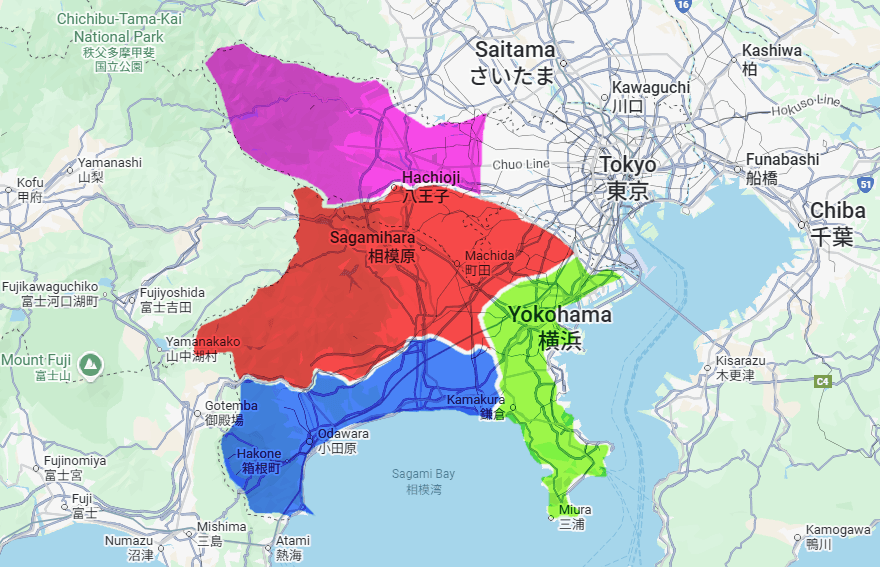
Purple: 164th Inf Reg | Red: 182nd Inf Reg | Blue: 132nd Inf Reg | Green: Div Arty Battalions
SCAP Occupation Instructions No. 2, issued to the Japanese government on September 25th, 1945, outlined how the demobilization of Japanese military equipment was to proceed under the occupation. All Japanese war equipment was to be immediately destroyed or scrapped, with the exception of items that were:
- Unique or novel enough to be of interest for US evaluation.
- Required by the US Army or Navy for operations.
- Suitable for repurposing to civilian use.
The US Army or Navy commanders overseeing the particular zone of occupation were responsible for the destruction of Japanese equipment located there. Equipment was generally to be destroyed at the very site where it was seized, after being appropriately inventoried.
A list of items to be preserved for the War Department for training purposes or as museum pieces was also distributed. For tanks, this entailed the procurement of the following:


Even at the end of the war, US technical intelligence had not yet obtained the correct identifications of several Japanese tank models, as can be seen from this list. Moreover, the designations of most advanced types under development were not yet even known.
All Japanese war equipment was scheduled to be collected and disposed of by October 31st, 1945.
Four days later on September 29th, 1945, Eighth Army Operational Directive No. 17 was distributed, which directed the units under the Eight Army, including the XI Corps which supervised the Americal Division, on the aforementioned procedures. It was clarified that technical items would be destroyed only with the supervision of qualified personnel from the technical services. For example, tanks of potential technical interest would have to be cleared by Ordnance Technical Intelligence.
From October 4th to 6th, units of the Americal Division had personnel trained as demolition teams in a brief session conducted by the 57th Engineer Combat Battalion in anticipation of the destruction of Japanese equipment. Demolition teams were instructed on how to destroy most types of known Japanese equipment.
On October 7th, a memorandum titled “Collection and Disposition of Captured Enemy Materiel” was sent by the Headquarters Americal Division, and sector commanders were ordered to begin disposing of Japanese weaponry in accordance with this memorandum on October 8th.
However, a memorandum by the XI Corps on the 7th had stated the following.
The target date of 31 October by General Headquarters cannot be met. The original order for this destruction was sound and gives a reasonable basis for destruction, however, Technical Intelligence Teams must complete their surveys by October 31 and be prepared to have some articles destroyed prior to their inspection, if any headway is to be made in clearing of the mass of equipment and ammunition…
Headquarters XI Corps: Memorandum to the Chief of Staff (7 Oct 1945)
Various sites with stockpiles of tanks lay within the occupational zone of the Americal Division. Most notably, the Sagami Army Arsenal, which directed the construction of almost all tanks in Japan, was squarely within the zone of the 182nd Infantry Regiment, along with the adjacent 4th Army Technical Research Institute, which similarly supervised the development of almost all Japanese tanks. The Sagami Arsenal itself had limited construction capabilities compared to civilian plants, and its own complete products had been evacuated through Army supply channels upon the Japanese surrender. Nonetheless, incomplete vehicles and vehicles awaiting repair remained at the Arsenal, although I have been unable to locate a complete inventory.
Incomplete List of Tank Sites Occupied By the Americal Division
These lists are not exhaustive, but aided in the search for the scenes depicted in the films. Most notably, the vehicle inventory of the Sagami Army Arsenal and immediately adjacent sites (4th Army Technical Research Institute, Army Ordnance School) were not located.
164th Infantry Regiment Zone
Kodaira Branch Depot of the Tōkyō Army Ordnance Supply Depot
Inventory by the 1st Cavalry Division 8 Sep 1945:
- 12 medium tanks
- 45 half tracks
- 70 armored cars
- 60 tankettes
- 91 service trucks
- 6 amphibious trucks
Inventory by the Americal Division 164th Infantry Regiment 2 Oct 1945:
(previously unreported vehicles)
- 8 “Type 97 medium tanks”, complete
- with 57mm gun: #1580, #231, #291
- no gun: #253, #4012, #193, #4024
- 2 “unknown model heavy tanks” (probably Chi-Nu), complete, with 75mm gun
- #89, #64
- 12 “Type I heavy tanks” (? probably Chi-Nu), complete, with 75mm gun
- #25, #87, #71, #86, #85, #88, #80, #90, #81, #83, #63, #84
- 4 “unknown model heavy tanks” (probably Chi-Nu), complete, with 75mm gun
- #22, #27, #28, #29
- 1 “medium tank with 57mm gun carriage and equipment with a mine destroyer attachment” (Chi-Yu)
- no serial on tank
Army Laboratory and Explosive Factory
Inventory by the 1st Cavalry Division 10 Sep 1945:
- 2 tanks
- 7 tankettes
- 2 trucks
Inventory by the Americal Division 164th Infantry Regiment 2 Oct 1945:
- 8 Type 89 medium tanks
- no gun: #148, #733, #828, #929
- with 57mm gun: #146, #734, #739, #741
- 3 Type 89 medium tanks
- with dummy gun: #601, #917
- with 57mm gun: #738
182nd Infantry Regiment Zone
Hashimoto Ordnance Supply Warehouse
(received equipment from Sagami to ship thru supply channels)
Inventory by the 1st Cavalry Division 10 Sep 1945:
- 19 medium tanks, chassis only without guns
- 3 light tanks, chassis only without guns
- 95 half tracks, chassis only without guns
- 68 personnel carriers, chassis only without guns
- 10 weapons for tanks
Army Academy
Inventory by 1st Cavalry Division 4 Sep 1945:
- 100 vehicles (trucks and tracked)
- 27 tanks (light, medium, heavy)
- 70 artillery (37mm-150mm all types AA and AT)
Inventory by 1st Cavalry Division 7 Sep 1945:
- 5 Type 95 75mm guns w/ caissons
- 8 Type 91 105mm howitzers
- 8 Type Year 41 75mm cavalry guns
- 5 Type 94 75mm mountain guns
- 4 90mm AA
- 2 Type Year 4 150mm howitzers (carriage)
- 4 Type 96 150mm howitzers w/ caissons
- 3 Type 92 105mm guns
- 1 Type 89 150mm gun
- 8 Type 88 75mm AA guns
- 3 Type 98 20mm AA-AT machine cannons
- 2 105mm howitzers
- 2 unidentified field pieces
- 9 tracked artillery tractors
- 3 Type 97 tankette
- 11 Type 95 light tanks
- 12 Type 97 medium tanks
- 1 unidentified tank
- 46 trucks
- 18 cars
- 6 AA searchlights
Division Artillery Zone
Tank Park
Inventory by Americal Division 221st Field Artillery Battalion 17 Sep 1945:
- 48 light and medium tanks
Inventory by Americal Division 221st Field Artillery Battalion 29 Sep 1945:
- 1 tracked personnel carrier
- 1 light tank for supplies
- 17 light tanks
- 20 medium tanks with 47mm guns
- 11 medium tanks with 12 cm howitzers with muzzle brake
- 76 gun mounts, naval, ~3in
Ikegai Automobile Manufacturing Co. Kawasaki Factory
Inventory by Americal Division 245th Field Artillery Battalion 16 Sep 1945:
- ~30 Type 95 light tanks, partially complete, no guns.
Inventory by Americal Division 245th Field Artillery Battalion 18 Sep 1945:
- 20 Type 95 light tanks, complete, no guns
- 21 Type 95 light tanks, incomplete
- 10 Type 97 light armored cars, incomplete
- 15 unknown model light or medium tanks, under repair
- 8 tracked vehicles for AA guns, incomplete
The Americal Division’s units immediately went to work destroying Japanese equipment in their respective sectors. It does appear that there were issues with items of technical interest being destroyed without proper identification and evaluation by Technical Intelligence. Most likely, in order to meet the stringent schedule of equipment disposition, tanks were being destroyed in bulk after approximate identification.

For example, on October 12th, the 182nd Infantry Regiment received an order to cease the destruction of all tanks at the Sagami Army Arsenal, as it had been decided that none were supposed to be destroyed until ID’d by Ordnance Technical Intelligence. However, footage from the 16th shows the 182nd Infantry Regiment continuing to destroy tanks in the vicinity of the Sagami Army Arsenal, so it’s unclear if ORD TI cleared the vehicles very rapidly, or if subsequent alternative decisions were made.
On October 19th, in an effort to stop the destruction of advanced Japanese tanks prior to evaluation, the CINCAFPAC ADVON ordered the Eighth Army to instruct all of its units to preserve Japanese tanks designated Type 1 ~ Type 5, along with all self propelled guns with a calibre 75mm or larger. This was directed by the Eighth Army to the corps under its management on October 21st as the 10th amendment to Operational Directive No. 17 (17/10).
By this time, the duties of the Americal Division in Japan were already coming to a close. From October 22nd to November 3rd, the Americal Division was gradually relieved of its occupational control by other divisions.
Identification of the Scrapping Sites
I wish I could go through my process for finding each of these locations, but honestly, I don’t entirely remember. Just know that I spent 8+ hour sessions staring at the footage and photographs, unit reports, maps, and aerial photography of countless potential areas for days on end, looking for any lineup of structures that could possibly work. I don’t know why, but I had to do it, and now that I’ve done it, I may as well share it in case it is vaguely useful to someone.
In most instances there was no locational information available to me, so this took quite a bit of time. Please note that I am not an expert at this, and the FOV and relative position of the camera is somewhat approximated.
Scene 1: Sagami Army Arsenal (35.5806, 139.3849)
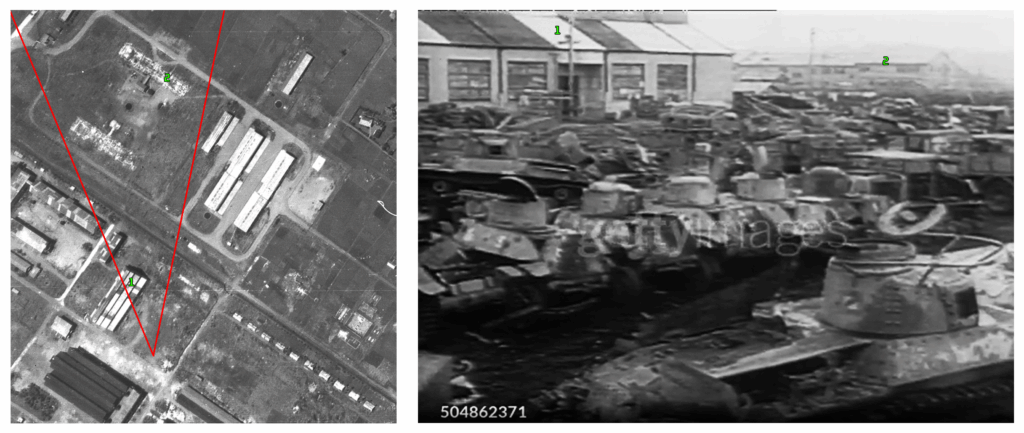
Only two reference points are used in this location, because the coloration of the roof panels on the closest building is an undeniable match. It seems that the roofs of many buildings at the Sagami Army Arsenal were painted with disruptive patterns, perhaps as a measure to confuse strategic bombing (like “dazzle camouflage” for warships). The Sagami Arsenal was relatively unaffected by strategic bombing until the end of the war, as the Japanese tank industry was not a high priority target.

Although the building marked “2” was already demolished by the time of US 1947 aerial photography, its appearance can be confirmed in the comparatively poor quality aerial photography of the Japanese Army from 1944.
This first scene of the film depicts the scrapping of tanks at the Sagami Army Arsenal. The Sagami Arsenal supervised the production at almost every single tank factory in Japan from shortly after its establishment in 1940 until the end of the war. It ultimately lay in the occupation zone of the 182nd Infantry Regiment of the Americal Division. In particular, this scene shows the northeast boundary of the Sagami Army Arsenal’s land, and the buildings in the background of the first angle belong to the adjacent 4th Army Technical Research Institute.


These additional scenes from the original film show a bit more of the abandoned vehicles, as well as some of the buildings outside of the highlighted FOV, further confirming the location.
According to US intel, completed products of the Sagami Army Arsenal had been evacuated through Army supply channels immediately upon the end of the war, so what remained here were likely tanks awaiting repair, modifications, or tanks not yet completed.

The Sagami Arsenal was mass producing the AT-SPG Na-To when the war ended, but it does not appear that this scene depicts any of those vehicles. The visible tanks appear to be largely Type 97 Medium Tanks (Chi-Ha) and Type 97 Light Armored Cars (Te-Ke).
The date of this footage is unknown, but it was likely recorded in early October of 1945. Today, the site of the former Sagami Army Arsenal is now the Sagami General Depot.
Scene 2: The Kodaira Branch of the Tōkyō Army Ordnance Supply Depot (35.7384, 139.4717)
This scene was by far the most difficult to locate – and, for a reason I’ll get to at the end of the article, it was also the primary site I was hoping to find. Many of the buildings of this depot were already demolished when useable-quality aerial photographs were taken, making the scene very difficult to recognize; not to mention that this is hardly a famous location.
The Kodaira Branch of the Tōkyō Army Ordnance Supply Depot was a primary armored vehicle hub for the Japanese Army’s logistical distribution. It fell into the occupation zone of the 164th Infantry Regiment of the Americal Division after the war.
The scene takes place on the edge of the foundation of a building that had already been demolished. It appears that you can see either the destroyed hulls of vehicles or burn marks from the explosions on the 1947 US aerial photographs.
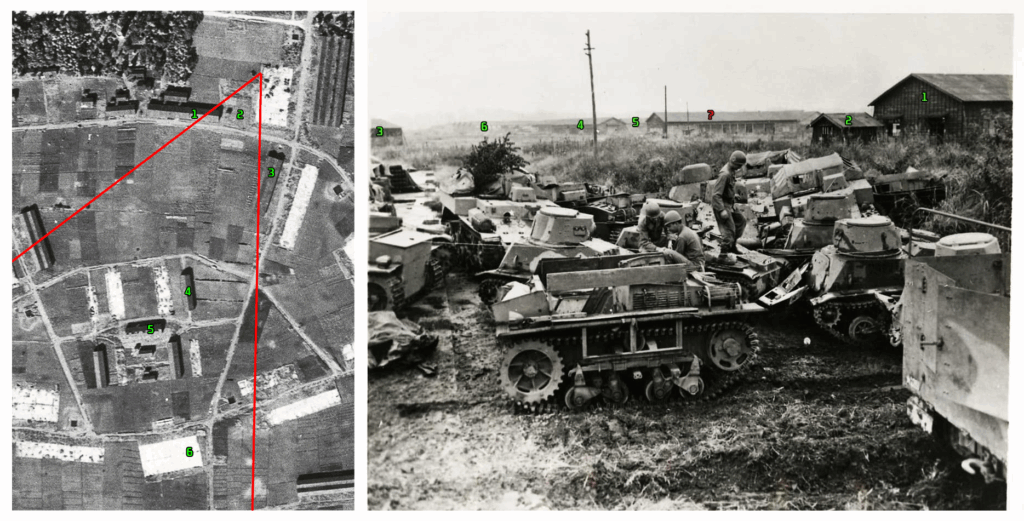
Building “6” was a “double M” roofed structure that was already wiped to its foundations when the US aerials were taken, but can be confirmed by its footprint relative to other buildings in the depot area. The building marked “?” is not present on the US aerial either, and in fact, there isn’t even a visible foundation. This caused me quite a bit of trouble, but it miraculously can be observed in 1946 aerials from a long horizontal distance away.

The bulk of the vehicles in this scene are Type 94 Light Armored Cars (Ho-Gō) and Type 97 Light Armored Cars (Te-Ke). A lone Type 89 Medium Tank (I-Gō) appears early on in the top of the wide pan. The odd-looking small tractors appear to be Marmon-Herrington TBS-30 tractors that were captured from the Dutch in Indonesia during the early phase of the war. There are also a few Type 100 Observation Advance Vehicles (Te-Re) present in the footage, some of which have their rear area tarped over. They are distinguished by the vertical mount for observation equipment just behind the raised part of the upper hull.


We also get a clear shot of a Type 98 Anti-Aircraft Cannon Tractor (Ko-Hi) with its engine block being destroyed.
Something of note is the presence of “Unknown Heavy Tanks” in the inventories of the Kodaira Branch Depot that were included in the last section. Assuming the caliber of their armament is accurate (75mm), I can only imagine that these were Type 3 Medium Tanks (Chi-Nu). However, there isn’t a clear view of any such tanks in this footage. That said, between the Ho-Gō turret and the soldier in this frame, there appears to potentially be some kind of large turret with a cupola peeking over the foliage, if not just a convincingly tank-looking building.


Today, the former site of the Kodaira Branch Depot of the Tōkyō Army Ordnance Supply Depot is now the Bridgestone Technical Center.
Scene 3: The Army Officer Academy
The third scene from the Getty Images film shows a soldier stuffing the barrel of an artillery gun with explosives. This took place at the Army Officer Academy in Zama. Due to the fact that it takes place in an open field with few identifying landmarks, it is immensely difficult and questionable in value to locate the exact position, but nonetheless I will take this opportunity to include a small amount of context.
The Army Officer Academy was an institution of the Japanese Army for training active-duty officers. It fell into the occupation zone of the 182nd Infantry Regiment. The full context of the original footage at Zama can be read in this footage card digitized by the NARA.
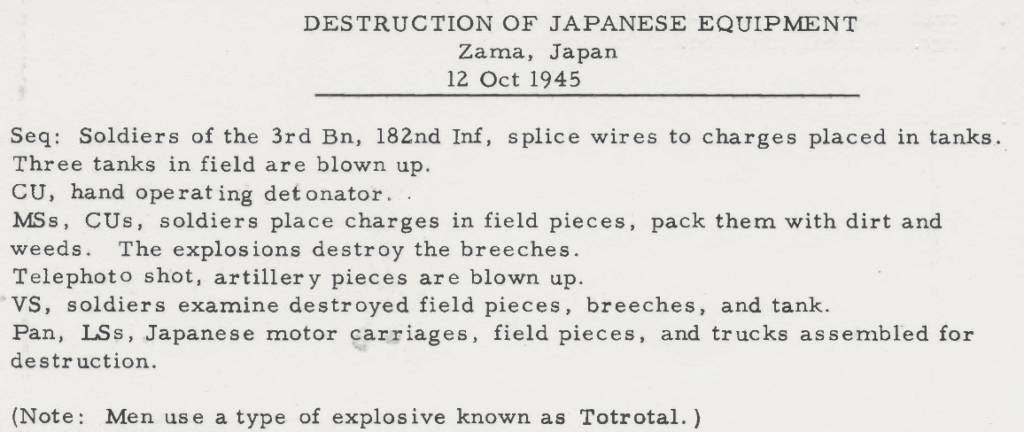
Three Type 1 Medium Tanks (Chi-He) were destroyed with explosives, as well as many other tanks and artillery pieces. Unfortunately, most of the frames of this film that I have are too indistinct to make out any particular vehicles.
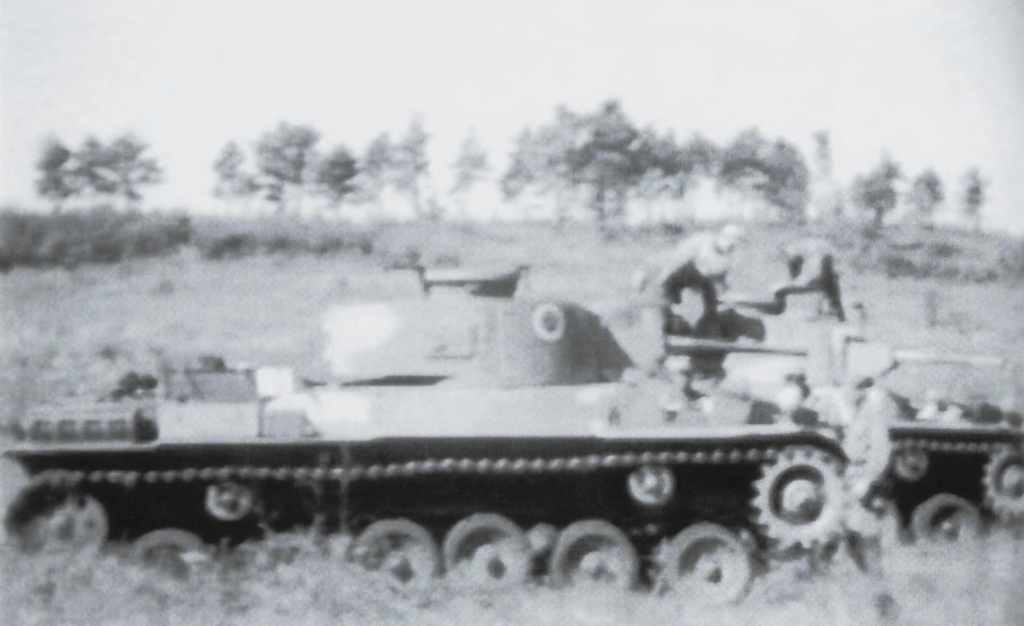
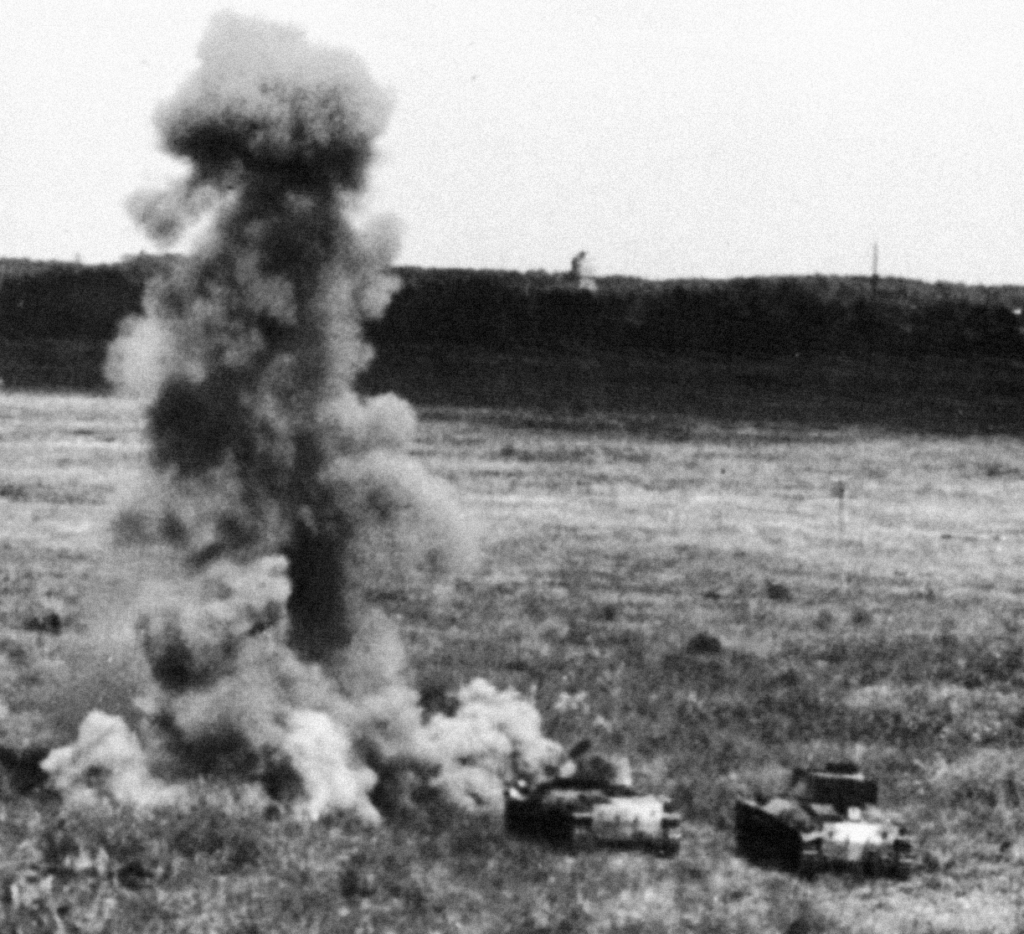
The Army Officer Academy is now Camp Zama, a US military installation.
Scene 4: The Army Ordnance School (35.5787, 139.3967)
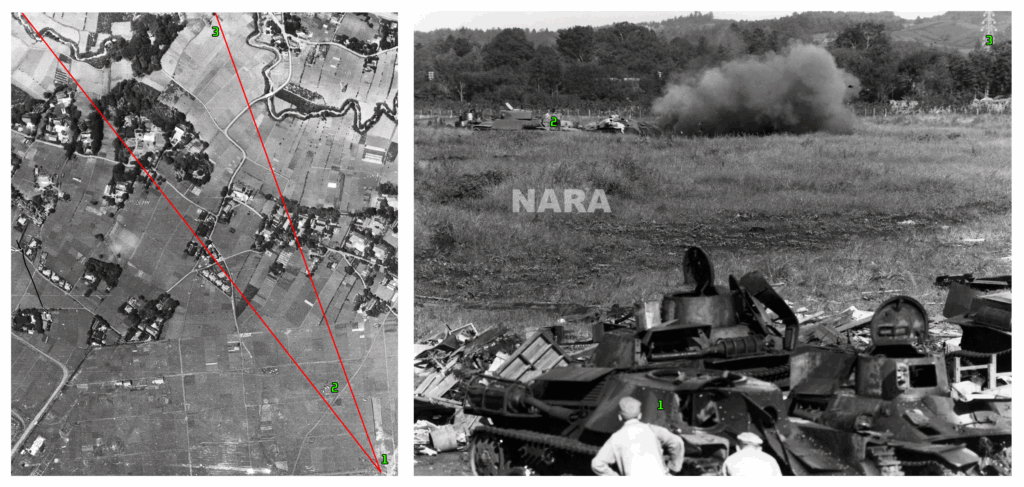
Photo Source
The last and most well known scene, which shows the imminent destruction of the mystery vehicles by the 182nd Infantry Regiment on October 16th, 1945. It took place at the Army Ordnance School in Fuchinobe, which was immediately east of the Sagami Army Arsenal / 4th Army Technical Research Institute.
I could hardly believe it, but I think that I found the exact tanks pictured in the film and photographs, judging by their relative positioning to an adjacent tank pile. In fact, my identification more or less relies on the conclusion that these are the very same tank piles, though general appearance of the environment and the relay towers makes it quite certain that the approximate location (this field just north of the Army Ordnance School) is accurate.
Although it’s too low quality to make out any details, if I am correct, this is now the second known photograph of these tanks.

And these are far from the only tanks left abandoned around the Army Ordnance School at Fuchinobe. There are countless hulls strewn around the place in aerial photographs. I am left wishing that 1940s aerial cameras were just a bit sharper… this could be incredibly interesting.

While looking into the 182nd Infantry Regiment, I found a photograph that I believe is related to the tank scrapping film, and can work as further location evidence for the above unknown tanks. Please see this photo from this article on a site dedicated to the 182nd Infantry Regiment. The photo depicts Fred G. Davis sitting in the cupola of a Type 97 Medium Tank, with the rear hull of another Type 97 in the immediate background.
According to the site author, the photo is thought to be taken in the Philippines. However, it appears that this is likely one of the Chi-Ha that can be seen in the scrapping at Fuchinobe (with a「う」marking on the turret). After looking over the details of both photographs, I believe this is probably the case. Just out of frame, to both the left and right, may be the unknown tanks… it’s almost a bit humorous that a photo was taken so close without capturing them.

Immediately south of the spot where this photo was taken is now the Ground Systems Research Center of the Japanese Ministry of Defense.
???
While this should be taken with a massive grain of salt, I have to admit: this is the main reason I was attempting to locate these scenes to begin with. While staring the background of the Kodaira footage scanning for anything interesting, I saw this strange vehicle facing to the right, and my first thought was “that has to be the Ho-Ru”.
The Experimental Type 5 47mm AT-SPG (Ho-Ru) was a late-war modification of the Ha-Gō light tank into a low-profile AT-SPG, with a Type 1 47mm Tank Gun in an open-backed superstructure. A prototype was reportedly at the Sagami Army Arsenal in June 1945, and mass production was expected to proceed with an order of 200 units in FY1945, but ultimately it is thought that production was never attained.
To be clear, I’m not confident as to what this “vehicle” actually is, but I feel like it’s worth pointing out for others to take a look at. For clarity, I’ve included two scans of the footage, as I believe they accentuate different parts of the “vehicle” more clearly.


Now, there is an extremely high chance that this is just some strange illusion caused by multiple tarped over objects. Without another view of this thing, I doubt it will be possible to identify what it actually is.
Still, the immediate impression that I got is that this is a low profile vehicle, with a partially tarped over open-backed fighting compartment and a long, small calibre gun. The rear of the vehicle seems to have a shape somewhat reminiscent of the Ha-Gō engine deck.

If this were a Ho-Ru, it would have to have an appearance somewhat different than the conventionally accepted one. For context, the widely known appearance of the Ho-Ru is based on a sketch made by Shinjirō Aonuma, who worked at the Sagami Army Arsenal and saw the prototype Ho-Ru in June 1945. For example, the roof of this “vehicle” appears flat, while the Ho-Ru drawn by Aonuma had an angular roof.

Is it even plausible that the Ho-Ru would be at the Kodaira Branch Depot? I think it’s a possibility, considering that American units had heard that the finished products of the Sagami Army Arsenal were evacuated via Army supply channels immediately upon the end of the war. Further, I’d think it particularly unusual if the Japanese had destroyed the Ho-Ru to hide it from American troops – although it was a late war modification, it was by no means a cutting-edge design.

Above, in red, I’ve also highlighted what seems to possibly be another mystery vehicle, whose outline also resembles a “superstructure” to me. This one is even more obscured than the “vehicle” behind it, so it’s difficult to tell if it even constitutes part of one vehicle itself.
I feel a bit silly suggesting that this random shape in the background of the footage could be something as incredible as the first image of an obscure prototype tank, but nonetheless I figured that I would at least mention it in case someone can do a better job of identifying what it truly is.
The mass destruction of Japanese armor in the early stages of the occupation has somewhat obscured the developmental history of Japan’s late-war tank technology. Ultimately, without better documentation or clearer footage, it is likely impossible to identify these vehicles for certain. My hope is that by mapping out these locations and providing alternative theories, this article can serve as a useful reference for anyone else trying to make sense of the traces of obscure vehicles that disappeared so soon after the war ended. If you spot something I missed, or have additional information, I would be interested to hear it.
Sources
- 戦車装備に関する綴 昭14
- 新中戦車設計条件 昭和14年3月6日 機械課委員
- 軍需動員に関する綴 昭和14年11月~昭和16年5月
- 19.陸技本秘乙第613号 昭和15年6月24日 管理工場管理再受任官変更に関する件通牒
- 研究試験実施記録概要(昭和十五年)
- J-Tank 第20号
- 小倉陸軍造兵廠史
- 日野自動車技術史
- 空白の昭和史第16巻
- 四研史
- Scale Model Review No.5
- Under the Southern Cross
- SCAP Occupation Instructions No. 2 (25 Sep 1945)
- Headquarters Eight Army: Operational Directive No. 17 (29 Sep 1945)
- Headquarters XI Corps: Memorandum to the Chief of Staff (7 Oct 1945)
- Headquarters Americal Division: Memorandum Collection and Disposition of Captured Enemy Materiel (7 Oct 1945)
- Headquarters Americal Division: Operations Memorandum No. 36 (8 Oct 1945)
- https://catalog.archives.gov/id/23665
- https://catalog.archives.gov/id/19216
Hi! Just loved your latest research on Japanese mistery tanks. I enjoyed also knowing about Hino engines. Do you have knowledge on tank fire control? I have seen a list (USNTM in Japan) of captured items, including a tank reflex gunsight. Nothing on optical rangefinders, although I`ve seen Amusing Hobby`s Ho-Ri II fielding a cupola so equipped.
Hi Carlos, thank you for commenting. I have some information about the periscopes and gun sights for all Japanese tanks. As for vehicle-mounted rangefinders, when it comes to tanks and self-propelled guns, I am only aware that they were equipped to the prototype of Ho-Ni I, the prototype observation tank Ka-So, and were planned for the incomplete prototype Ho-Ri.
Thanks, Qaz, for your heads-up! Please continue posting off-the-box subjects.
Hey qaz,
I hope all is well. I just want to let you know that I found this fascinating. Great work!